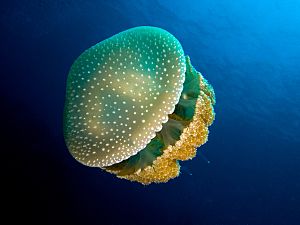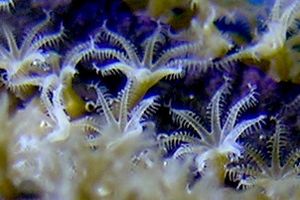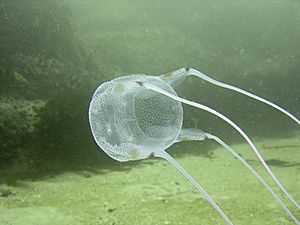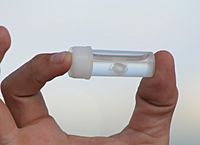Jellyfish facts for kids
Jellyfish are amazing sea animals that belong to a group called Cnidaria. They are also known as 'Medusozoa'. Jellyfish have soft bodies and long, stinging tentacles. They use these tentacles to catch their food. Most jellyfish float and drift in the ocean currents, but some can move by squeezing their bodies.
Quick facts for kids Jellyfish |
|
|---|---|
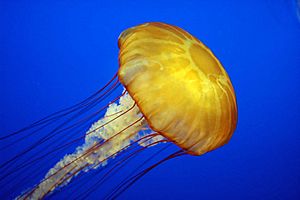 |
|
| Pacific sea nettle (Chrysaora fuscescens) | |
| Scientific classification | |
| Kingdom: | Animalia |
| Phylum: | Cnidaria |
| Subphylum: | Medusozoa |
| Groups included | |
| Cladistically included but traditionally excluded taxa | |
Contents
- What are the main types of jellyfish?
- Why are they called jellyfish?
- How do jellyfish look and move?
- Where do jellyfish live?
- What do jellyfish eat?
- Who eats jellyfish?
- How do jellyfish help other animals?
- The jellyfish life cycle
- Jellyfish and humans
- Interesting facts about jellyfish
- Images for kids
- See also
What are the main types of jellyfish?
There are four main groups, or classes, of jellyfish in the Cnidaria family:
- Scyphozoa: These are known as the true jellyfish. There are over 200 different kinds.
- Cubozoa: These are called box jellyfish because of their cube-shaped bodies. There are about 20 species.
- Staurozoa: These are stalked jellyfish. They are usually attached to the seabed. About 50 species exist.
- Hydrozoa: This group includes many small jellyfish. There are about 1,000 to 1,500 species that produce jellyfish forms.
Why are they called jellyfish?
The name "jellyfish" has been used since 1796. Some people prefer to call them "jellies" or "sea jellies." This is because they are not actually fish, which have backbones. Animals like shellfish and starfish also have "fish" in their names but are not true fish.
When many jellyfish gather together, it's called a "smack" or a "smuck." Sometimes, a sudden increase in jellyfish numbers is called a "bloom."
How do jellyfish look and move?
Jellyfish have soft, bell-shaped bodies. They also have long, stinging tentacles. These tentacles are used to catch their food, which includes tiny ocean creatures like plankton, small crustaceans, or little fish.
Most jellyfish move by squeezing their bell-shaped bodies. This pushes them through the water. However, they don't have much control over where they go. They mostly drift along with the ocean currents. A few types of jellyfish are different; they are attached to the seabed by stalks and cannot move around freely.
Where do jellyfish live?
Jellyfish live all over the world. You can find them in shallow surface waters and deep parts of the ocean. Most jellyfish live in salty ocean water. They float in the sea and eat small marine animals.
Only a few types of jellyfish live in fresh water. One well-known example is the Craspedacusta sowerbii. This freshwater jellyfish is less than an inch (2.5 cm) wide. It is clear and does not sting.
What do jellyfish eat?
Jellyfish eat many things, including plankton, small crustaceans, tiny fish, fish eggs, and other jellyfish. They catch their food using their venomous tentacles.
Some jellyfish even live in a special partnership with algae. The jellyfish carries the algae into sunlight. In return, the algae make nutrients for the jellyfish through photosynthesis.
Who eats jellyfish?
Not many animals eat jellyfish, but some do. Sea turtles and certain fish, like the sunfish, are known predators. Sea anemones might also eat jellyfish that float too close. Other animals that prey on jellyfish include tunas, sharks, swordfish, and penguins. If jellyfish wash up on the beach, foxes and birds might eat them.
How do jellyfish help other animals?
Some small fish are not affected by jellyfish stings. They live safely among the jellyfish's tentacles. This helps the small fish hide from predators. They can also share the food that the jellyfish catches. For example, the cannonball jellyfish has a special relationship with ten different fish species. It also lives with the longnose spider crab, which stays inside the jellyfish's bell, sharing food and nibbling its tissues.
The jellyfish life cycle
Most jellyfish have two main stages in their life cycle.
The first stage is the polyp stage. In this form, the animal looks like a small stalk with feeding tentacles. Often, these polyps are attached to the sea floor or another hard surface. They usually don't move around much. A polyp that stays in one place is called sessile. Some polyps can float freely. Polyps usually have a mouth surrounded by tentacles that face upwards. They can live alone or in groups. Some polyps can even make more polyps without needing a partner, which is called asexual reproduction. Most polyps are very tiny, only a few millimeters big.
In the second stage, these tiny polyps create jellyfish. Each new jellyfish is called a medusa. These tiny jellyfish swim away from the polyp and then grow bigger. They feed on plankton in the ocean. Jellyfish can reproduce in two ways: sexually and asexually. Adult jellyfish that have enough food often release eggs and sperm every day. This usually happens at the same time for many jellyfish, often at dawn or dusk, controlled by light.
Most jellyfish are either male or female. The adults release their sperm and eggs into the water. The eggs are then fertilized and grow into new organisms.
Medusae have a radially symmetric, umbrella-shaped body called a bell. This bell usually has tentacles around its edge that catch prey. A few types of jellyfish skip the polyp stage and grow directly from fertilized eggs into new jellyfish. Jellyfish in the medusa stage usually live for about six months before they die.
Jellyfish and humans

Jellyfish as food
In some parts of the world, people eat jellyfish. They are considered a special food in some Asian countries. Certain types of jellyfish are pressed and salted to remove extra water. Researchers in Australia have even called them a "perfect food." They are sustainable, full of protein, but don't have too many calories.
Jellyfish can spoil very quickly after they are caught. Sometimes, they are dried to keep them fresh longer. There is also a special cleaning process that can take up to 40 days. Jellyfish are often eaten in salads with soy sauce or vinegar.
Jellyfish in research
Some jellyfish can glow in the dark. This is because they have a special substance called green fluorescent protein. Scientists have learned to use this protein as a glowing marker for genes. This helps them study how genes work in other cells or organisms.
Jellyfish in aquariums

Many public aquariums display jellyfish. Often, their tanks have a blue background, and lights shine from the side. This makes the jellyfish stand out, as they are very clear in nature and hard to see.
Jellyfish are not used to living in small, closed spaces. They rely on ocean currents to move them around. Special aquarium exhibits, like those at the Monterey Bay Aquarium, have carefully designed water flows. They often use round tanks so the jellyfish don't get stuck in corners. Jellyfish have also become popular in home aquariums, but they need similar special equipment.
Jellyfish stings
Jellyfish have stinging cells called nematocysts. These cells can hurt humans. Thousands of swimmers around the world get stung every year. The effects can range from a little discomfort to serious injury or even death.
Most jellyfish stings are not deadly. However, stings from some box jellyfish, like the sea wasp, can be very dangerous and even deadly.
If you get stung, Vinegar (a weak acid) might help with box jellyfish stings. However, it does not help with stings from the Portuguese man o' war. If vinegar is not available, salt water might help. Soaking the sting in hot water can be the best way to reduce pain from a Physalia sting. Putting an ice pack on it can also help a lot with the pain.
-
Box jellyfish are small and venomous.
Gently scraping the affected skin, perhaps with the edge of a credit card, can help remove any remaining stinging cells. After cleaning the skin, a special cream called hydrocortisone can be applied to reduce pain and swelling. Medicines called antihistamines can help with itching. For very serious box jellyfish stings, doctors use special medicines called antivenins.
Jellyfish causing problems
When there are many jellyfish, they can cause problems. Large groups of jellyfish can fill and break fishing nets. They can also crush the fish caught in the nets.
Jellyfish can also clog cooling systems. They have caused power outages in several countries. For example, jellyfish caused a big blackout in the Philippines in 1999. They also damaged the Diablo Canyon Power Plant in California in 2008. Jellyfish can even stop desalination plants and ship engines from working.
Interesting facts about jellyfish
- Jellyfish are very old animals. They have been around for at least 500 million years, and maybe even 700 million years or more! They are the oldest group of animals with many organs.
- The smallest jellyfish are only a few inches wide.
- The largest type of jellyfish is the Lion's mane jellyfish. Its body can be over 3 feet (1 meter) wide, and its tentacles can be as long as 60 meters.
- Some of the most dangerous jellyfish include the box jelly (like the Chironex and Carukia barnesi types) and the tiny, two-centimeter-wide Irukandji jelly. Their venomous sting can kill a person.
- Some jellyfish glow in the dark. This is called phosphorescence.
- Box jellyfish have very good eyesight compared to other jellyfish. Each one has 24 eyes, and two of them can even see color. They are one of the few animals that can see all around them (360 degrees).
- Jellyfish kill 20 to 40 people each year in the Philippines alone.
- In 2006, the Spanish Red Cross treated 19,000 swimmers who were stung by jellyfish along the Costa Brava.
Images for kids
-
A purple-striped jellyfish at the Monterey Bay Aquarium
-
Fossil jellyfish, Rhizostomites lithographicus, from the Kimmeridgian (late Jurassic, 157 to 152 mya) of Solnhofen, Germany
-
Discharge mechanism of a nematocyst
-
The lion's mane jellyfish (Cyanea capillata) is one of the largest species.
-
The developmental stages of scyphozoan jellyfish's life cycle:1–3 Larva searches for site4–8 Polyp grows9–11 Polyp strobilates12–14 Medusa grows
-
Jellyfish locomotion is highly efficient. Muscles in the jellylike bell contract, setting up a start vortex and propelling the animal. When the contraction ends, the bell recoils elastically, creating a stop vortex with no extra energy input.
-
Moon jellyfishes can live in northern hemisphere seas, such as the Baltic Sea.
-
Global harvest of jellyfish in thousands of tonnes as reported by the FAO
-
Rehydrated jellyfish strips with soy sauce and sesame oil
-
The hydromedusa Aequorea victoria was the source of green fluorescent protein, studied for its role in bioluminescence and later for use as a marker in genetic engineering.
-
Pacific sea nettles (Chrysaora fuscescens) in an aquarium exhibit
See also
 In Spanish: Medusozoa para niños
In Spanish: Medusozoa para niños
- Jellyfish dermatitis
- List of prehistoric medusozoans
- Ocean sunfish, a significant jellyfish predator


